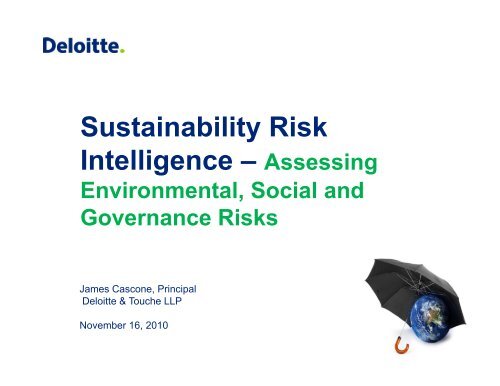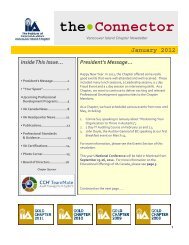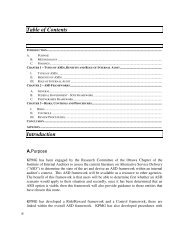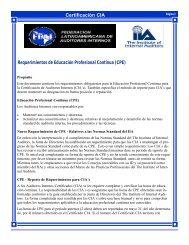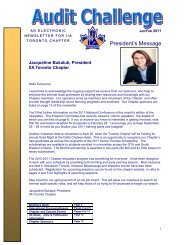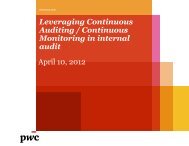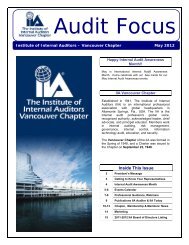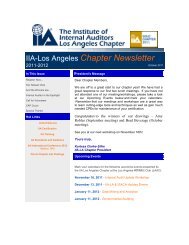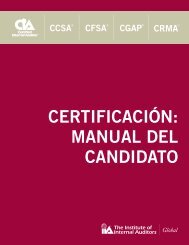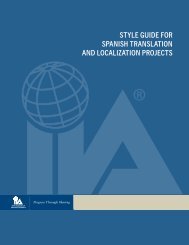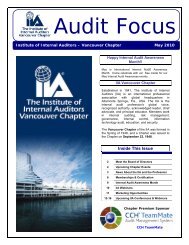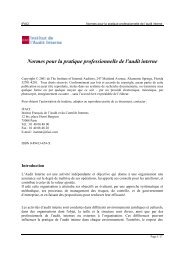Sustainability Risk Intelligence â Assessing - The Institute of Internal ...
Sustainability Risk Intelligence â Assessing - The Institute of Internal ...
Sustainability Risk Intelligence â Assessing - The Institute of Internal ...
You also want an ePaper? Increase the reach of your titles
YUMPU automatically turns print PDFs into web optimized ePapers that Google loves.
<strong>Sustainability</strong> <strong>Risk</strong><strong>Intelligence</strong> – <strong>Assessing</strong>Environmental, Social andGovernance <strong>Risk</strong>sJames Cascone, PrincipalDeloitte & Touche LLPNovember 16, 2010
Agenda1. Defining <strong>Sustainability</strong>2. Common Standards and Frameworks3. Identifying <strong>Sustainability</strong> <strong>Risk</strong>s4. <strong>Internal</strong> Audit Value PropositionCopyright © 2010 Deloitte Development LLC. All rights reserved.
Defining <strong>Sustainability</strong>
What is <strong>Sustainability</strong>?<strong>The</strong> World Commission on Environment and Development (WCED)issued a report at a 1987 UN conference that defined sustainabledevelopment:“Sustainable development is development that meets the needs <strong>of</strong> thepresent without compromising the ability <strong>of</strong> future generations to meettheir own needs.”Alternative perspective:Sustainable organizations utilize business practices that enhancestakeholder value, minimize negative impacts on the environment, andhave a positive effect on society.Short version - “Producing more with less”
What’s Driving <strong>Sustainability</strong>?Population GrowthWater ScarcityResource DepletionDemand for Energy& ProductionPollutants & WasteStream MgmtEcosystemImpactsIncreased awareness and significance <strong>of</strong> environmental and social issuesShareholder and public activism onenvironmental & social issuesIncreased regulation andoversightShifting market demandsand growth opportunitiesInstitutional Investors (SRI)influencing capital marketsEvolving frameworks & standardsConsumers favoring sustainableoptions (Clean Tech, Fair Trade)Increased demand for transparencyand communications<strong>Sustainability</strong> reporting andverification may be mandated<strong>Sustainability</strong> becomes a key driver<strong>of</strong> value and brand equity<strong>Sustainability</strong> has become a business imperative for most industriesCopyright © 2010 Deloitte Development LLC. All rights reserved.
Why is <strong>Sustainability</strong> Important?Increased recognition that financial statements capture only a portion <strong>of</strong> corporaterisks and value-creation potential. Intangible factors are increasingly seen ashaving a greater impact on enterprise value, such as:1) Governance practices (e.g., codes <strong>of</strong> conduct, anti-corruption/FCPA practices)2) Brand and reputation management (e.g., 3 rd party relationships, social media)3) Energy and resource utilization (e.g., sourcing, efficiencies and waste stream)4) Health & Safety (e.g., wellness, occupational incidents, environmental remediation)5) Human rights and labor practices (e.g., supplier risks in emerging markets).Companies are developing Key Performance Indicators (KPIs), measurementmethods, and reporting systems to more effectively address the potential businessand financial risks <strong>of</strong> these impacts, and to better respond to stakeholders.* <strong>The</strong> Global Reporting Initiative (GRI) publishes the most widely usedsustainability reporting framework – issued guidance for 14 industries.
Common Standards andFrameworks
FrameworksFinancial Assessment FrameworksESG performance measures are viewed as leading indicators <strong>of</strong> long-term financialperformance and potential sources <strong>of</strong> risk and/or value creation. No judgments made on acompany’s intrinsic ethical worth.Institutional investors use analytical models that integrate environmental, social andgovernance (ESG) criteria into the investment analysis and seek to balance the level <strong>of</strong>ESG-driven risk (e.g., reputational, supply chain, geo-political, legal, and regulatory risk)and management’s ability to manage such risks.Non-Financial Industry Assessment FrameworksVoluntary sustainability assessment frameworks are developed by the private, public, andNGO sectors to promote certain corporate behaviors relevant to ESG issues. <strong>The</strong>ytypically apply to all organizations in all industries and measure adherence to standardsand performance frameworks, but are not risk based assessments.<strong>Sustainability</strong> assessment criteria may be based upon principles, standards, and metricsestablished by the GRI, the U.N. Global Compact (UNGC), the International Organizationfor Standardization (ISO), and other standard-setting organizations.
Financial Frameworks – Indexes<strong>The</strong> quality <strong>of</strong> a company's strategy and it’s ability to manage opportunities andrisks related to ESG activities are increasingly being quantified by rating agencies.<strong>The</strong> following is an example <strong>of</strong> commonly known indexes:- Dow Jones <strong>Sustainability</strong> Indexes (DJSI)- Carbon Disclosure Leadership Index (CDLI)- Carbon Performance Leadership Index (CPLI)- FTSE4Good Index Series- NASDAQ OMX CRD Global <strong>Sustainability</strong> 50 Index- S&P U.S. Carbon Efficient Index* <strong>The</strong>re are currently over 100 sustainability ratings in existence, compared to approximately 20 in 2000.
Non-Financial FrameworksNon-financial frameworks provide guidance to organizations on measuring andreporting on their sustainability performance. <strong>The</strong>y foster consistency and provideinsights into key performance indicators such as energy and water use, GHGemissions, waste and social performance indicators related to human rightsissues in order to help improve a company’s ability to manage sustainability risks.<strong>The</strong> following are common frameworks and standards:• GRI G3 Guidelines• GHG Protocol• ISO14001:2004 / 14004:2004 – Environmental Management Systems• ISO 26000:2010 – Social Responsibility• UN Global Compact Management Model (10 Principles)• Social Accountability Standard (SA8000)
Identifying <strong>Sustainability</strong><strong>Risk</strong>s
<strong>The</strong> <strong>Risk</strong> Intelligent Organization - <strong>Sustainability</strong> MaturityModel (Illustrative only)<strong>Assessing</strong> your culture and governance structure will help determine the maturity <strong>of</strong> yoursustainability efforts and the types <strong>of</strong> risks (value protection vs. creation) that are top <strong>of</strong> mind withmanagement. This will also highlight areas <strong>of</strong> improvement (gaps).Four-phase development <strong>of</strong> sustainability maturity within a company and the changes that an organization should undertake togradually shift from being an isolated activity to an integrated process1 2What’s Your Current State?MatureFollower3Leader4InnovatorStages <strong>of</strong> <strong>Sustainability</strong> ContinuumFollower Mature Leader Innovator• Focuses on complianceand on meeting theorganization’s most basicexpectations.• <strong>The</strong> company takes a moreproactive approach, based onreducing risk and minimizingimpact on stakeholders.• <strong>The</strong> company initiates adialogue with stakeholders.Value creation takes placethrough sustainabilityactivities; <strong>Sustainability</strong>becomes a more critical part<strong>of</strong> the governance structure.• <strong>Sustainability</strong> tasks arecompletely integrated intothe strategy <strong>of</strong> the corebusiness. <strong>Sustainability</strong>provides a source <strong>of</strong>innovation and competitiveadvantage for the business.Copyright © 2010 Deloitte Development LLC. All rights reserved.
<strong>Sustainability</strong> Governance – <strong>Risk</strong> OwnershipBoard & CEO<strong>Sustainability</strong> & climate change strategyChiefFinancialOfficerR&DChiefMarketingOfficerChiefOperatingOfficerChiefInformationOfficerFacilitiesHead <strong>of</strong>SupplyChainChief PeopleOfficer<strong>Sustainability</strong><strong>Risk</strong> DisclosuresClean TechInvestments<strong>Sustainability</strong>marketingCarbon datacollection &managementCloudComputing /Energy efficientnetworksOnsite lowcarbon energygenerationSustainableupstream supplychainEmployeeengagementCarbonregulatoryimpactsSustainableproduct / servicedevelopmentSustainableproduct / servicemarketingLow carbonmanufacturingprocessesSustainablebuildingSustainablewaste streammanagementSocialComplianceCarbonaccounting &reportingSmart griddevelopment &implementationRegulatoryaffairs &lobbyingLow carboncorporate fleetsFacility energyefficiencyLow carbondistribution &logistics<strong>Sustainability</strong>assurance &verificationCarbon capture& storageGreen energystrategyESGcomplianceExternalresearch fundingTax credits &incentivesSource: Verdantix Critical Moments® Climate Change & <strong>Sustainability</strong> Spending Market ForecastCopyright © 2010 Deloitte Development LLC. All rights reserved.
<strong>Risk</strong> <strong>Intelligence</strong> – A Holistic ApproachEnhancing your Enterprise <strong>Risk</strong> Assessment process:• Identify current and contemplated initiatives / programs- Assess sustainability governance structure- Verify the business case (ROI, Strategic alignment)• Assess sustainability related communications- Informal communications (social media)- Formal reporting (10-K risk factors, sustainability report)• Evaluate the regulatory climate (regional, national, global)- Evaluate impacts on suppliers and customers (EPA, AB 32, Food & Product Safety)- Consider SEC Climate Change interpretive guidance / proxy disclosure enhancements• Benchmark the field- Competitor assessment and marketplace analysis- Determine if your company is listed on an index and performance criteria used- Survey stakeholders (customers, suppliers, NGOs, investors)Copyright © 2010 Deloitte Development LLC. All rights reserved.
Regulatory Drivers in the United StatesTwo significant regulatory developments in the US are driving the need formore robust reporting and disclosure capabilities.• <strong>The</strong> EPA Mandatory Greenhouse Gas Reporting Rule became effectivein 2010, with the first reports due by March 2011:– Monitor and reporting required for ~10,000 facilities across 17 industries(emitters over 25,000 mt CO 2 e)– Data collection at the facility level: CO 2 , CH 4 , N 2 O, SF 6 , HFCs, PFCs• On February 2, 2010, the SEC issued an interpretive release thatoutlines the Commission’s views on applying existing disclosure rules toclimate change matters:– Potential positive impacts on the registrant, not just negative effects– Affects from international accords and treaties related to climate change andgreenhouse gas– Actual and potential indirect consequences <strong>of</strong> climate change-related regulationsor business trends– Actual and potential impacts <strong>of</strong> the physical effects <strong>of</strong> climate change on thebusiness
Identifying and <strong>Assessing</strong> <strong>Sustainability</strong> <strong>Risk</strong>sIdentify key risks across organizational silos and heat map focus areas*:- Governance- Strategy- Operations/infrastructure- Compliance<strong>The</strong> IIA’s IPPF - Evaluating Corporate Social Responsibility / SustainableDevelopment (February 2010):‒ Defines CSR and Sustainable Development‒ Discusses potential CSR / <strong>Sustainability</strong> risks and impacts‒ Describes various CSR / <strong>Sustainability</strong> activities‒ Discusses potential reporting implications‒ Suggests approaches to evaluating CSR / <strong>Sustainability</strong> within yourorganization‒ Provides suggested approaches to evaluating and auditing CSR /<strong>Sustainability</strong> activities* Refer to the Deloitte <strong>Sustainability</strong> & Climate Change <strong>Risk</strong> <strong>Intelligence</strong> Map for additional details.Copyright © 2010 Deloitte Development LLC. All rights reserved.
Potential <strong>Sustainability</strong> <strong>Risk</strong>sOrganizations may be exposed to a variety <strong>of</strong> risks associated with<strong>Sustainability</strong> activities, including the following*:• Reputational: Damage due to unethical actions (e.g., including externalbusiness partners), negative publicity (e.g., social media), lack <strong>of</strong>transparency in disclosed sustainability information, governance lapses, orthe appearance <strong>of</strong> indifference to social issues (e.g., human rights).• Compliance: Failure to comply with regulations relating to the environment,health, safety (food, product, human), employment/labor, and fraud (FCPA).• Operational: <strong>Risk</strong>s associated with an organization’s impact on theenvironment and community resulting from its production processes(including supply chain partners) or service delivery activities.• Financial: Suboptimal ROI from sustainability initiatives, inefficient use <strong>of</strong>R&D funds (Clean Tech, sustainable products), unrealized savings (taxcredits & incentives), investments in SRI funds.* This is a partial listing <strong>of</strong> potential risks and is not meant to be a complete list <strong>of</strong> all sustainability related risks.
<strong>Internal</strong> Audit ValueProposition
Improved Board <strong>Risk</strong> OversightUsing a <strong>Risk</strong> Intelligent approach to conducting risk assessments will help youdefine the scope <strong>of</strong> your organizational sustainability efforts, measure the impacton enterprise value, and determine potential exposures / vulnerabilities.Audit Committees and Management are coming under increasing pressure frommajor stakeholders to explain how sustainability drivers impact their business.-Top line growth remains a challenge, one that can be answered by developing sustainableproducts/services.- Shareholders are pressuring companies to disclosure their sustainability exposures.- Business partners are requesting more information on these exposures from theirsuppliers.- Regulators are taking a hard look at what sustainability aspects should be regulated.- Heightened media attention reinforces stakeholder interest and concern.<strong>Internal</strong> audit is well positioned to educate Audit Committee members andmanagement on emerging ESG risks and to improve the Board’s ability toexercise its risk oversight responsibilities.
Enhanced Enterprise <strong>Risk</strong> Management Program<strong>The</strong> business impact <strong>of</strong> sustainability is complex, and risks vary by industry andgeographic scale. Many companies do not know how to address these risks, andmay summarily dismiss sustainability without fully understanding their vulnerability.<strong>The</strong>refore, companies need to understand the sustainability uncertainties thatimpact shareholder value.<strong>Internal</strong> audit can help enhance existing ERM programs and assist managementwith identifying potential risk factors that should be disclosed, for example:• Commodity, raw material and energy price risks• ESG legislative and regulatory requirements• Impact <strong>of</strong> resource scarcity and emissions• Strategic risks (competitors’ marketplace positioning for “green” products)• Disruption to suppliers, distributors and partners from ESG infractions• Divergent stakeholder perceptions• Brand / reputational risk (health & safety, human rights violations)
<strong>Internal</strong> Audit Plan – Assuring ESG Metrics<strong>Internal</strong> audit can add value and improve an organization’s ESG initiatives bybringing an independent and objective approach to evaluating KPIs.An internal audit <strong>of</strong> sustainability activities can improve the quality and reliability <strong>of</strong>reported data as well as management's ability to make good decisions. <strong>The</strong> scope<strong>of</strong> an internal audit may include:- An assessment <strong>of</strong> the reporting process- Testing the accuracy and consistency <strong>of</strong> sustainability data included in allreports and external communications- Verifying if data is presented according to an accepted reporting framework.
<strong>Assessing</strong> ESG <strong>Risk</strong>s - SynopsisProvide an integrated perspective on sustainability risks:Value Protection – Focus on risk management, compliance, preventing reputationaldamage, and controls to minimize potential fines, penalties, and litigation.Value Creation – Strategic focus on developing sustainable products / services,strengthening stakeholder relationships, and operating more efficiently.Common Organizational Challenges:- <strong>Sustainability</strong> initiatives may not be integrated into the overall business strategy- Governance structure may not be well defined- Limited assurance over data (KPI) accuracy, reliability and completeness- Ineffective measuring, monitoring and reporting processes or systems.
Question and AnswerSession
About DeloitteDeloitte refers to one or more <strong>of</strong> Deloitte Touche Tohmatsu Limited, a UK private company limited byguarantee, and its network <strong>of</strong> member firms, each <strong>of</strong> which is a legally separate and independent entity.Please see www.deloitte.com/about for a detailed description <strong>of</strong> the legal structure <strong>of</strong> Deloitte ToucheTohmatsu Limited and its member firms. Please see www.deloitte.com/us/about for a detailed description<strong>of</strong> the legal structure <strong>of</strong> Deloitte LLP and its subsidiaries


